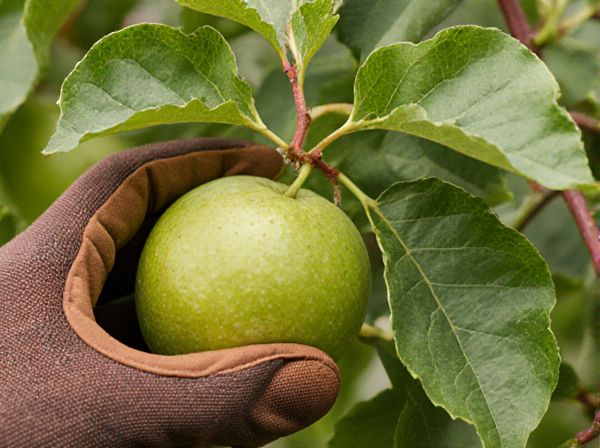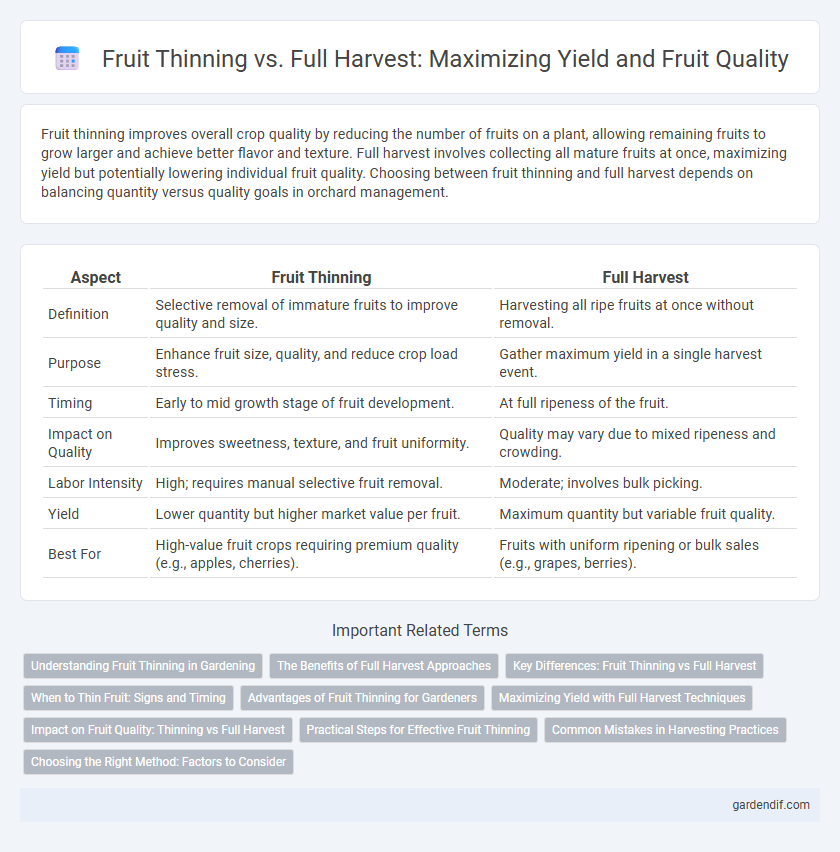
Fruit Thinning vs Full Harvest Illustration
Fruit thinning improves overall crop quality by reducing the number of fruits on a plant, allowing remaining fruits to grow larger and achieve better flavor and texture. Full harvest involves collecting all mature fruits at once, maximizing yield but potentially lowering individual fruit quality. Choosing between fruit thinning and full harvest depends on balancing quantity versus quality goals in orchard management.
Table of Comparison
| Aspect | Fruit Thinning | Full Harvest |
|---|---|---|
| Definition | Selective removal of immature fruits to improve quality and size. | Harvesting all ripe fruits at once without removal. |
| Purpose | Enhance fruit size, quality, and reduce crop load stress. | Gather maximum yield in a single harvest event. |
| Timing | Early to mid growth stage of fruit development. | At full ripeness of the fruit. |
| Impact on Quality | Improves sweetness, texture, and fruit uniformity. | Quality may vary due to mixed ripeness and crowding. |
| Labor Intensity | High; requires manual selective fruit removal. | Moderate; involves bulk picking. |
| Yield | Lower quantity but higher market value per fruit. | Maximum quantity but variable fruit quality. |
| Best For | High-value fruit crops requiring premium quality (e.g., apples, cherries). | Fruits with uniform ripening or bulk sales (e.g., grapes, berries). |
Understanding Fruit Thinning in Gardening
Fruit thinning enhances overall fruit quality and size by reducing the number of developing fruits on a plant, which directs more energy to fewer fruits. This gardening practice helps prevent limb damage, improves air circulation, and reduces disease risk compared to full harvest approaches. Understanding optimal timing and techniques for fruit thinning can significantly boost yield efficiency and fruit marketability.
The Benefits of Full Harvest Approaches
Full harvest approaches maximize fruit yield and uniformity by allowing all mature fruits to be collected simultaneously, enhancing overall market value and reducing labor costs associated with multiple picking sessions. This method supports optimized resource allocation, as trees maintain consistent fruit load and energy distribution, improving fruit size and quality. Emphasizing full harvest strategies can also reduce post-harvest handling and minimize waste, contributing to more sustainable orchard management practices.
Key Differences: Fruit Thinning vs Full Harvest
Fruit thinning involves selectively removing immature fruits to improve the size and quality of the remaining crop, enhancing overall yield potential and reducing stress on the plant. Full harvest entails collecting all mature fruits at once, maximizing immediate yield but possibly compromising fruit size and quality due to resource competition. The key difference lies in balancing quantity and quality: fruit thinning prioritizes optimal growth conditions for each fruit, while full harvest aims for maximum output regardless of individual fruit development.
When to Thin Fruit: Signs and Timing
Fruit thinning is essential during early fruit development, typically 2 to 4 weeks after full bloom, to improve fruit size and quality while preventing branch damage. Signs to thin include overcrowded fruit clusters, small or misshapen fruits, and uneven fruit spacing on branches. Timely fruit thinning reduces competition for nutrients and sunlight, leading to a more productive and healthier harvest season.
Advantages of Fruit Thinning for Gardeners
Fruit thinning improves fruit size and quality by reducing competition among developing fruits, leading to healthier and more robust crops. It enhances overall tree health by preventing nutrient overload and minimizing risks of branch breakage caused by excessive fruit weight. Gardeners also benefit from easier harvesting and better air circulation, reducing disease incidence and promoting longer-lasting yields.
Maximizing Yield with Full Harvest Techniques
Full harvest techniques maximize fruit yield by collecting all mature produce at peak ripeness, reducing waste from overripe or damaged fruit. This method contrasts with fruit thinning, which deliberately removes excess fruit to improve size and quality but may limit total volume. Utilizing full harvest strategies enhances overall marketable yield and supports efficient resource use on orchards or farms.
Impact on Fruit Quality: Thinning vs Full Harvest
Fruit thinning significantly improves fruit quality by allowing remaining fruits to develop larger size, better color, and enhanced flavor due to reduced competition for nutrients and sunlight. In contrast, a full harvest without thinning often results in smaller, lower-quality fruits with diminished sweetness and texture uniformity. This practice also reduces the risk of fruit disorders and increases overall market value by producing premium-grade produce.
Practical Steps for Effective Fruit Thinning
Effective fruit thinning involves selectively removing excess fruits early in the growing season to improve the size and quality of the remaining fruits. Practical steps include identifying fruit clusters to thin, spacing fruits evenly on each branch, and using clean, sharp tools to avoid damage. Consistent monitoring and timely thinning promote better air circulation and sunlight exposure, reducing disease risk and enhancing overall yield quality.
Common Mistakes in Harvesting Practices
Common mistakes in fruit thinning and full harvest include improper timing, which can lead to reduced fruit quality and yield. Overthinning results in wasted resources and fewer fruits, while underthinning causes overcrowding and smaller, less marketable produce. Failure to differentiate between thinning and full harvest stages often leads to premature picking, affecting fruit taste and shelf life.
Choosing the Right Method: Factors to Consider
Choosing the right method between fruit thinning and full harvest depends on factors such as crop type, desired fruit size, and market demand. Fruit thinning improves fruit quality and reduces disease risk by allowing more sunlight and airflow, beneficial for high-value or specialty fruits. Full harvest maximizes yield but may result in smaller or less uniform fruits, making it suitable for crops destined for processing or bulk sales.
Fruit Thinning vs Full Harvest Infographic

 gardendif.com
gardendif.com